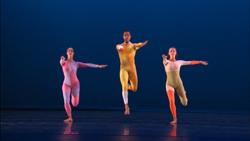Description
Atlas records a late-2000's revival performance of the 1993 dance CRWDSPCR, which Merce Cunningham choreographed using the choreographic software program LifeForms. In program notes to a performance of the dance, Cunningham suggested that the vowel-less title, pronounced either "crowd spacer" or "crowds pacer," referred to the way in which technology both crowded space and quickened the pace of daily life. Atlas's camera mimics a computer screen by maintaining an objective, static frame and rarely zooming in on particular dancers, notably making an intimate approach during the long, slow solo that contrasts with the dance's overall frenetic, staccato paces. A blue screen that forms the backdrop for the dance is traversed by a full company of dancers, who wear multi-colored leotards resembling harlequin computer pixels or digital grids. Cunningham's stage organization also permits the viewer to focus his or her attention on any of several groupings of moving dancers, much as one would when working on a computer with several windows open simultaneously. In this way, CRWDSPCR merges Cunninham's vision of a decentered organization of the stage with his use of the computer as a conceptual extension of chance-generated decision-making.
CRWDSPCR is among the earliest pieces exemplifying Cunningham's use of the choreographic software program LifeForms (now known as DanceForms). The LifeForms program represents the human body as a series of concentric circles. Its user can dictate and simultaneously notate a wide variety of choreographic variables. The computer screen, divided into squares like a checkerboard, becomes a virtual stage that can be electronically tilted or rotated so that genderless, wire-frame figures can be viewed from any number of perspectives. To hone the seemingly impossible choreography of CRWDSPCR, Cunningham not only mined the potential of manipulating his digital avatars within the software, but in translating this work to the studio tested the real physical possibilities of his dancers.
Significantly, at the age of seventy, Cunningham became the first choreographer of international renown to create work in dialogue with software technologies, when he was forced to explore the limitations that severe arthritis imposed upon his own freedom of movement. In a 1994 essay, Cunningham writes of his use of a dance computer as the fourth in a series of "Events That Have Led To Large Discoveries," prompting historians such as Roger Copeland to describe Cunningham's use of LifeForms as a logical extension of the collage aesthetic that animates much of his earlier work. Cunningham's use of the computer has also been described as an extension of his interest in integrating vernacular movement into the context of the dance. In CRWDSPCR, dancers aim at exact angles with their arms and feet, changing phrases quickly and methodically, as though transitioning from one keyframe to the next.
Cunningham Dance Foundation presents Merce Cunningham Dance Company in CRWDSPCR (1993). Choreography: Merce Cunnigham. Music: "Blues '99," John King. Decor/Costumes/Lighting: Mark Lancaster. A film by Charles Atlas.
Choreography: Merce Cunningham. Direction: Charles Atlas. Dancers: Cédric Andrieux, Jonah Bokaer, Lisa Boudreau, Brandon Collwes, Julie Cunningham, Emma Desjardins, Holley Farmer, Jennifer Goggans, Rashaun Mitchell, Koji Mizuta, Marcie Munnerlyn, Daniel Squire, Andrea Weber. Music Performed by: John King, David Tudor. Film Production Manager: Cathy Richards. Director of Photography: Jarred Alterman. Additional Cameras: Mike Harlow, Joshua Thorson. Utility/Sound: Adam Chimera. Production Assistant: Gerry Mak. Editing: Glen Fogel. Reconstruction of CRWDSPCR: Jeannie Steele, Robert Swinston. Production Manager: Josh Johnson. Lighting Director: Megan Byrne. Music Recording: Stephan Moore. Wardrobe Supervisor: Anna Finke.
For Cunningham Dance Foundation. Artistic Director: Merce Cunningham. Founding Music Director: John Cage (1912-1992). Assistant to the Choreographer: Robert Swinston. Music Director: Takenisha Kosugi. Executive Director: Trevor Carlson. Company Manager: Rebecca Wilhelms. Chief Financial Officer: Lynn Wichern. Archivist: David Vaughn. Merce Cunningham Dance Company's Dancers are members of the American Guild of Musical Artist AFL-CIO, the labor union representing professional dancers, singers, and staging personnel in the United States.
Special Thanks: Simon Egleton, Janine Melillo, Kinetic Effects Research Inc., Nam June Paik, Bénédicte Pesle, Artservice International, Silicon Graphics Computer Systems, Simon Fraser University, Chris Kogler, The Wexner Center for the Arts, Bill Horrigan, Melody Clavert, Sage Cowles for her unparalleled dedication to the Cunningham Dance Foundation, Judith R. Fishman for ther support for the realization of this project, Carol K. Walker, Dean, SUNY purchase School of the Arts, and the Board of Directors of the Cunningham Dance Foundation. Funding: CRWDSPCR was originally commissioned by the American Dance Festival with generous support from the John S. and James L. Knight Foundation and the Rockefeller Foundation, This revival is supported through public funds from the National Endowment for the Arts, which believes that a great nation deserves great art.
Cunnigham Dance Foundation filming initiatives are archived as part of To Merce, with major support from the Carnegie Corporation of New York, Sage and John Cowles, Judith and Alan Fishman, The HRK Foundation, and the Rockefeller Brohters Fund.
This film was made possible through grants from Save America's Treasures, a partnership between the National Endowment for the Arts and the National Park Service, Department of the Interior. Major Support also provided by the Andrew W. Mellon Foundation and the Ford Foundation. Copyright 2009 Cunningham Dance Foundation, Inc.
